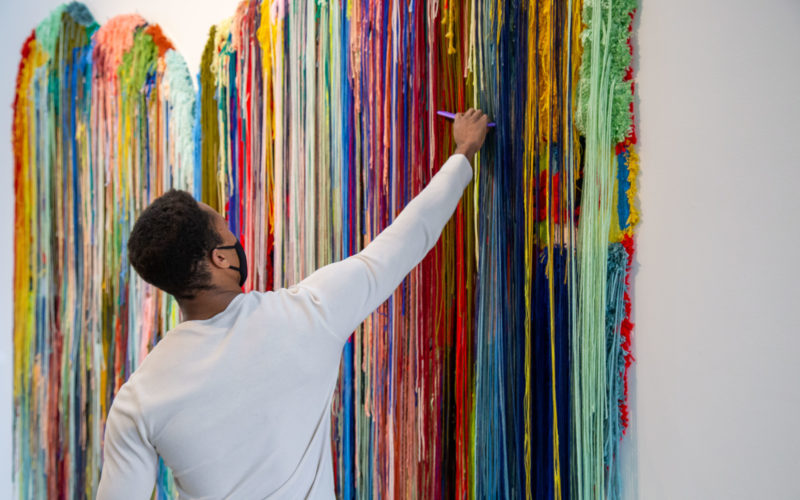Make a gift to help keep Atlanta Contemporary free, safe, and open to all.
Coloring
Coloring
Bill Adams, Paul Stephen Benjamin, Rutherford Chang, Anne Lindberg, Kate Shepherd
January 10, 2014 – March 8, 2014
The vocabulary of artmaking can be deceiving. We can analyze how line or texture, for example, can contribute to the overall impact of various paintings, sculptures, and prints, but these single formal elements can also be a subject worthy of inquiry. As the artists included in Coloring reveal, conditions of color can offer a range of physical and conceptual links —- to the human body, nature, popular culture, and language.
Bill Adams produces works that collapse painting and sculpture, and his palette of bold or delicate pinks, yellows, and blues might remind viewers of Frank Stella’s famous comment from 1964, “I tried to keep the paint as good as it was in the can.” Adams is aware of the references that color can bring —- be it a blood red lozenge-shape or a totemic cat rendered in Bic-pen blue. His constructions often rest on wooden legs and lean against the wall, asking us to consider them as painterly props that act like signs and surrogate figures.
Paul Stephen Benjamin’s video installations present a continuous sequence of broken words in various fonts and hand-drawn styles, along with images selected from historical and contemporary media sources. References to “blackness” abound, from the color of the discarded monitors that Benjamin stacks to make his sculptural towers, to the faces of notable African Americans including Shirley Chisholm, Condoleezza Rice, Eldridge Cleaver, Beyoncé, and LeBron James. The sputtering and hypnotic rhythms of this work seems to suggest that a cohesive message about identity is all but impossible, but worthy of continued effort.
Rutherford Chang meditates on the color white through an ambitious process of collecting multiple copies of The Beatles, the two-disc set released in 1968 and commonly referred to as “The White Album.” These vinyl LPs are arguably the same, except that each bears the signs of distinct use, discoloration, and attempts at care-taking by their owners. At this writing, Chang has accumulated over 900 copies, and they are installed on the wall and in bins for viewers to examine, along with a digital recording of 100 copies of the songs overlaid on top of each other, registering various scratches, dust, and differences in the pressing of the records.
Encountering an Anne Lindberg installation, one finds oneself approaching a cloud of color, produced by lines of colored thread that have been tautly drawn between neighboring walls and held in place by numerous staples. Lindberg’s atmospheric work delivers lessons in saturation and dispersal, and one might consider her inquiry as an extension of the color experiments of predecessors including Joseph Albers, Robert Irwin, and James Turrell, as well as acts of ephemeral architecture.
Kate Shepherd is known for Minimalist panel paintings, often featuring delicate diagrams rendered on top of glossy enameled surfaces whose finish reflects the presence of the viewer. These qualities suggest that the artist is interested in how one can recognize and appreciate various sensations from the natural and industrial world. Shepherd’s recent works in laser-cut plywood are based on walks in New York’s Central Park and offer surfaces that are cracked and subtly cantilevered, their fragility charged with emotion.
For some, the exhibition title Coloring might bring to mind the childhood process of filling in, or not, the predetermined areas of an activities book. For our purposes, the word recognizes the serious play of adults, whose uses of color have more complex implications and consequences.
Bio
Paul Stephen Benjamin
Paul Stephen Benjamin received his BA from the University of Illinois at Urbana-Champaign and his MFA from Georgia State University. In 2019, he exhibited Pure, Very, New at Marianne Boesky Gallery, NY and participated in the Havana Biennial in Matanzas, Cuba. He’s been included in solo and group exhibitions at a variety of institutions and art spaces, including Tacoma Art Museum, Tacoma, WA (2018), Telfair Museum Jepson Center, Savannah, GA (2018), The Studio Museum in Harlem, New York, NY (2017), Museum of Contemporary Art of Georgia, Atlanta, GA (2017), High Museum of Art, Atlanta, GA (2016), among others. He has received a range of awards and fellowships, including The Southern Art Prize (2018), The State Fellow of Georgia (2018), Museum of Contemporary Art of Georgia Fellow (2017), Artadia Award (2014), Winnie B. Chandler Fellowship, Hambidge Distinguished Fellowship, and the Forward Arts Emerging Artists Award. Benjamin is a finalist for the distinguished Hudgens Prize in Georgia (2019). He was born in Chicago and lives and works in Atlanta.
- Curated by Stuart Horodner
